Join our community to see how developers are using Workik AI everyday.
Supported AI models on Workik
GPT 5.2, GPT 5.1 Codex, GPT 5.1, GPT 5 Mini, GPT 5, GPT 4.1 Mini
Gemini 3 Flash, Gemini 3 Pro, Gemini 2.5 Pro, Gemini 2.5 Flash
Claude 4.5 Sonnet, Claude 4.5 Haiku, Claude 4 Sonnet, Claude 3.5 Haiku
Deepseek Reasoner, Deepseek Chat, Deepseek R1(High)
Grok 4.1 Fast, Grok 4, Grok Code Fast 1
Models availability might vary based on your plan on Workik
Features

Generate Schema with AI
Prompt Workik AI to build SQL or NoSQL schemas — structure-aware, scalable, and instantly usable.

Refactor with AI Suggestions
Edit schemas visually while AI recommends relations, keys, and normalization improvements.

Simulate with Mock Data
Use AI to auto-generate schema-consistent mock data for realistic testing and prototyping.

Document Schema Automatically
Let AI generate detailed documentation from your schema — relations, constraints, and descriptions included.
How it works
Create your Workik account for free and launch your first code environment instantly.
Connect to GitHub, GitLab, or Bitbucket—or upload your schema in JSON/CSV. Define DB type, schema style, and relational structure preferences.
Use AI prompts or schema files to build your schema. Visual editor allows real-time changes and AI-assisted refactoring.
Auto-generate schema docs, test with mock data, invite collaborators, and export to SQL/NoSQL formats.
supercharge development
Try For Free

FEATURES

Generate schemas using AI prompts with structured relational logic.

Refactor legacy or messy schemas with AI-backed normalization insights.

Define DB engines and formats for SQL, NoSQL, or hybrid databases.

Auto-generate schema diagrams for visual validation and debugging.

Simulate with mock data and test schema-bound edge cases effortlessly.

Export architecture in version-controlled formats to sync with CI/CD pipelines.
Try For Free

FEATURES

Use natural language to describe your database and generate schemas.

Understand table relationships through visual, editable ER diagrams.

AI explains keys, constraints, and column types in simple terms.

Generate mock data to test frontend or APIs without writing SQL.

Collaborate with the team and iterate schema versions in a shared space.

Export clean schema files ready to use in real-world projects.
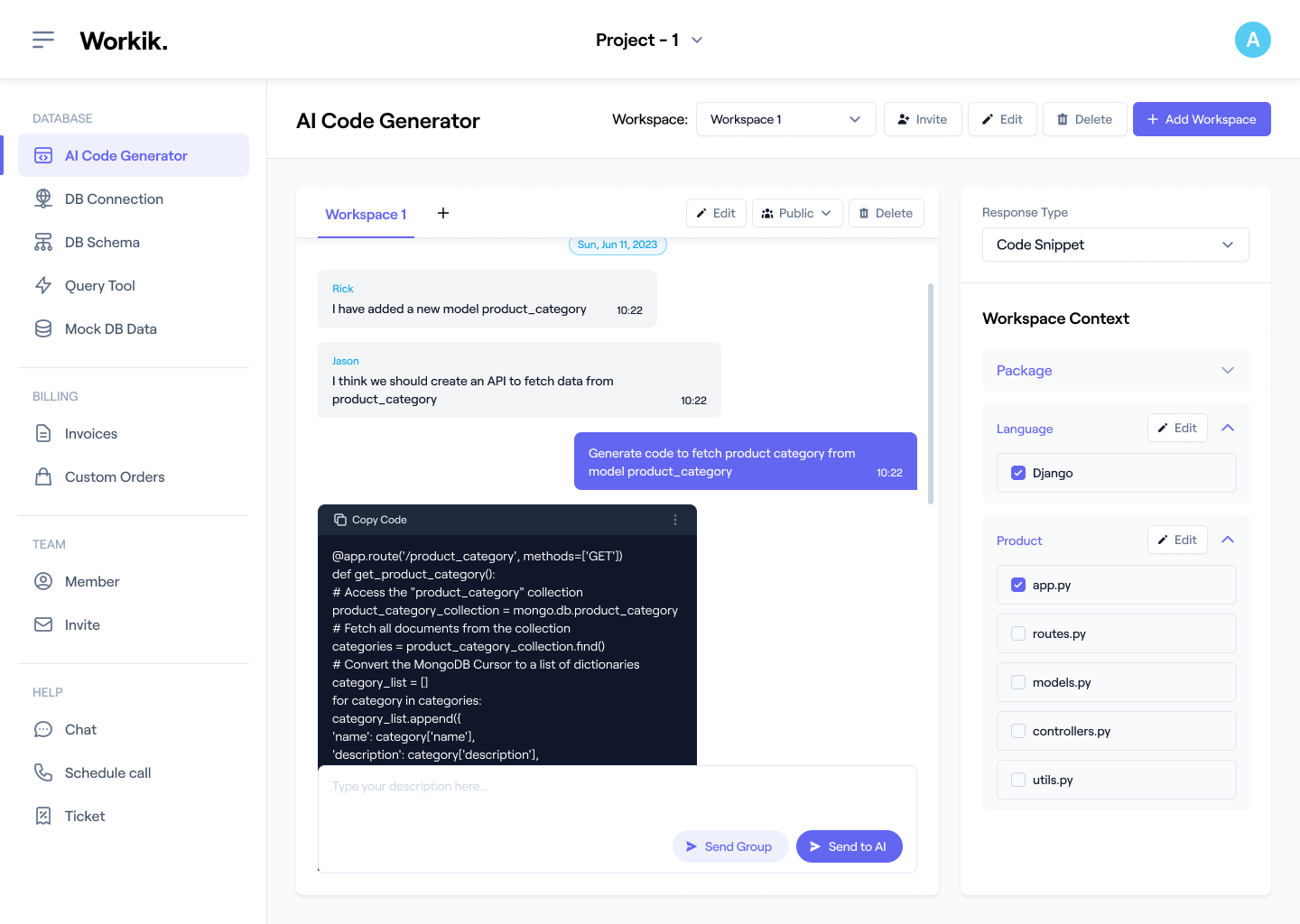

Expand
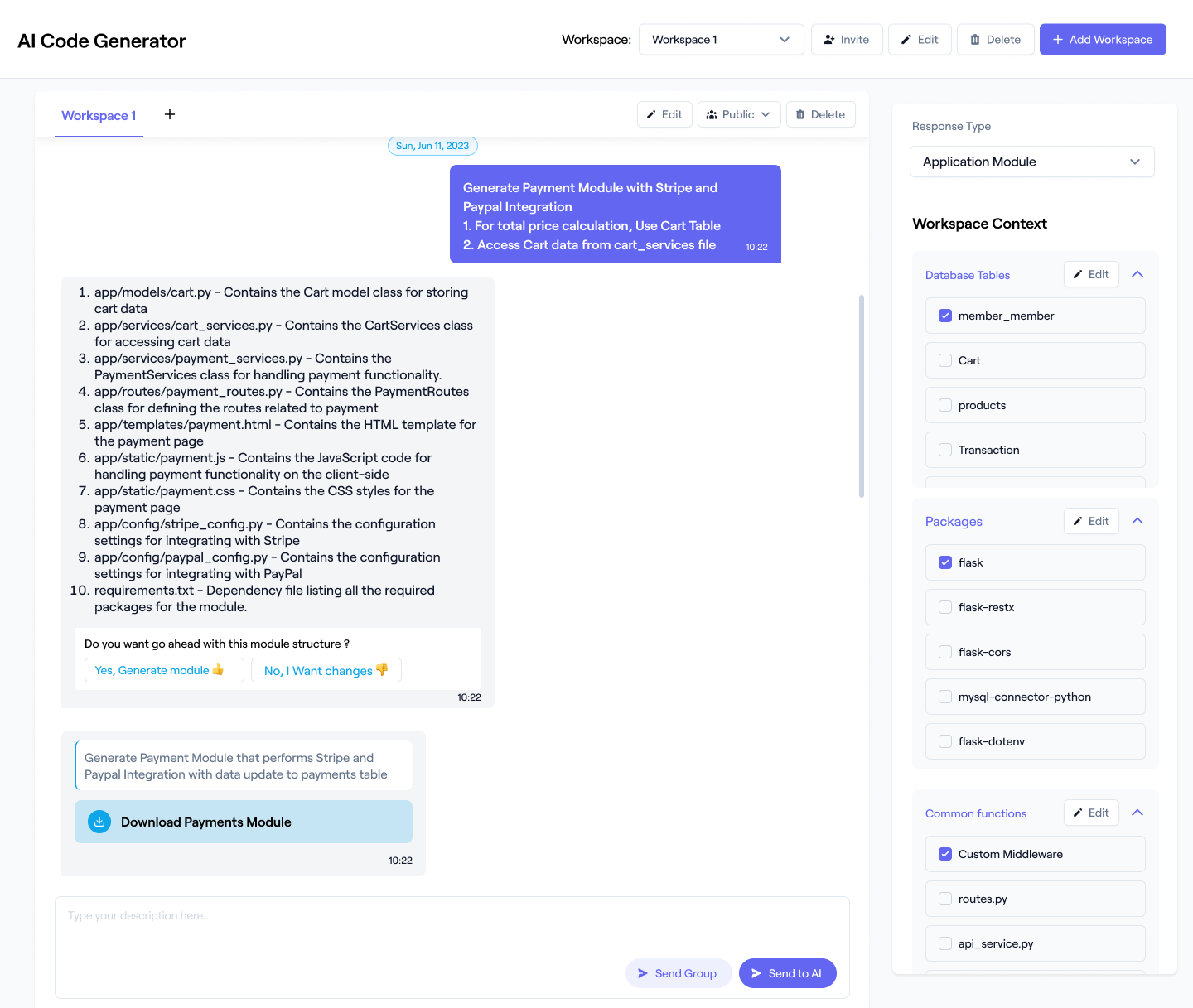

Expand
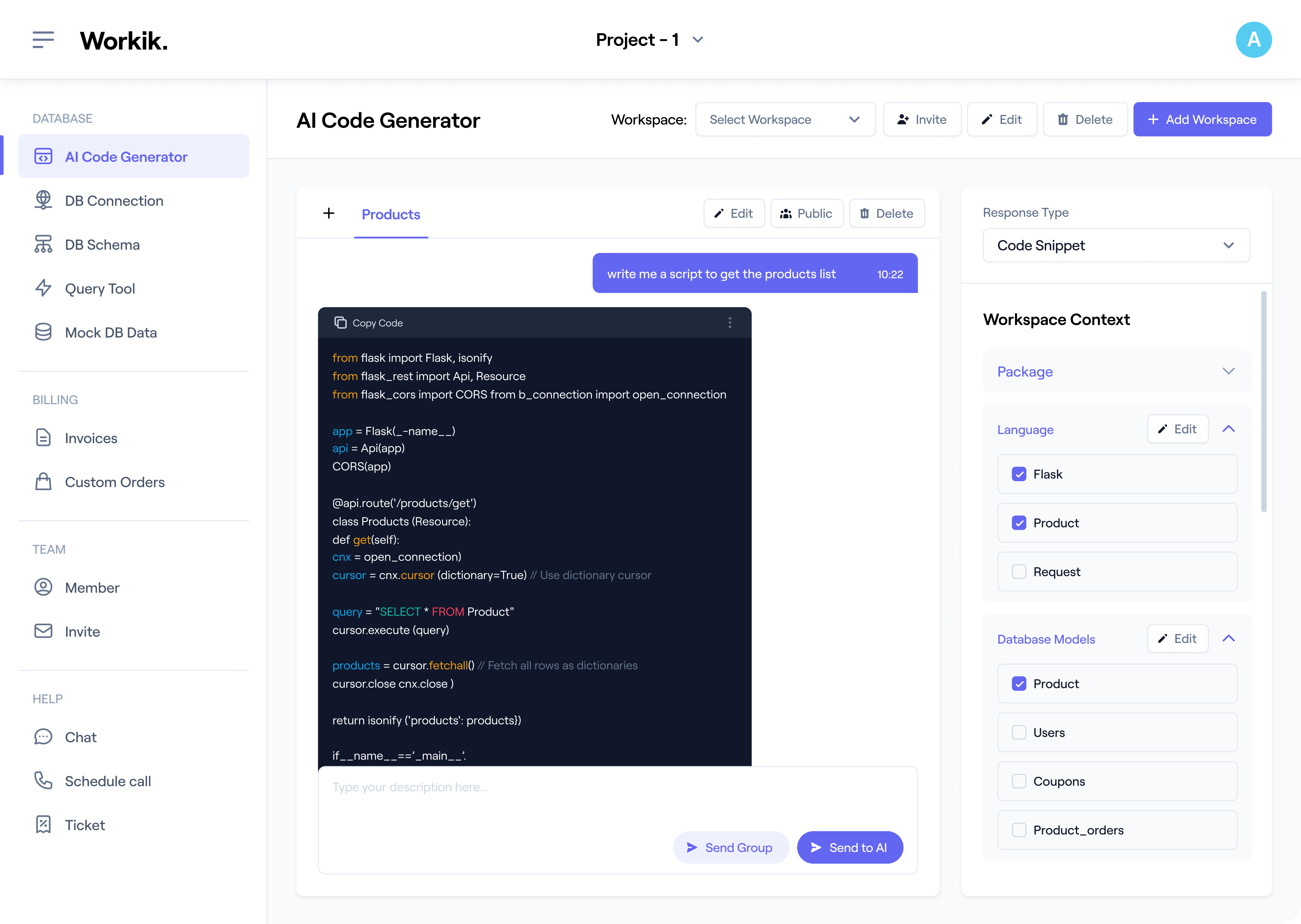

Expand
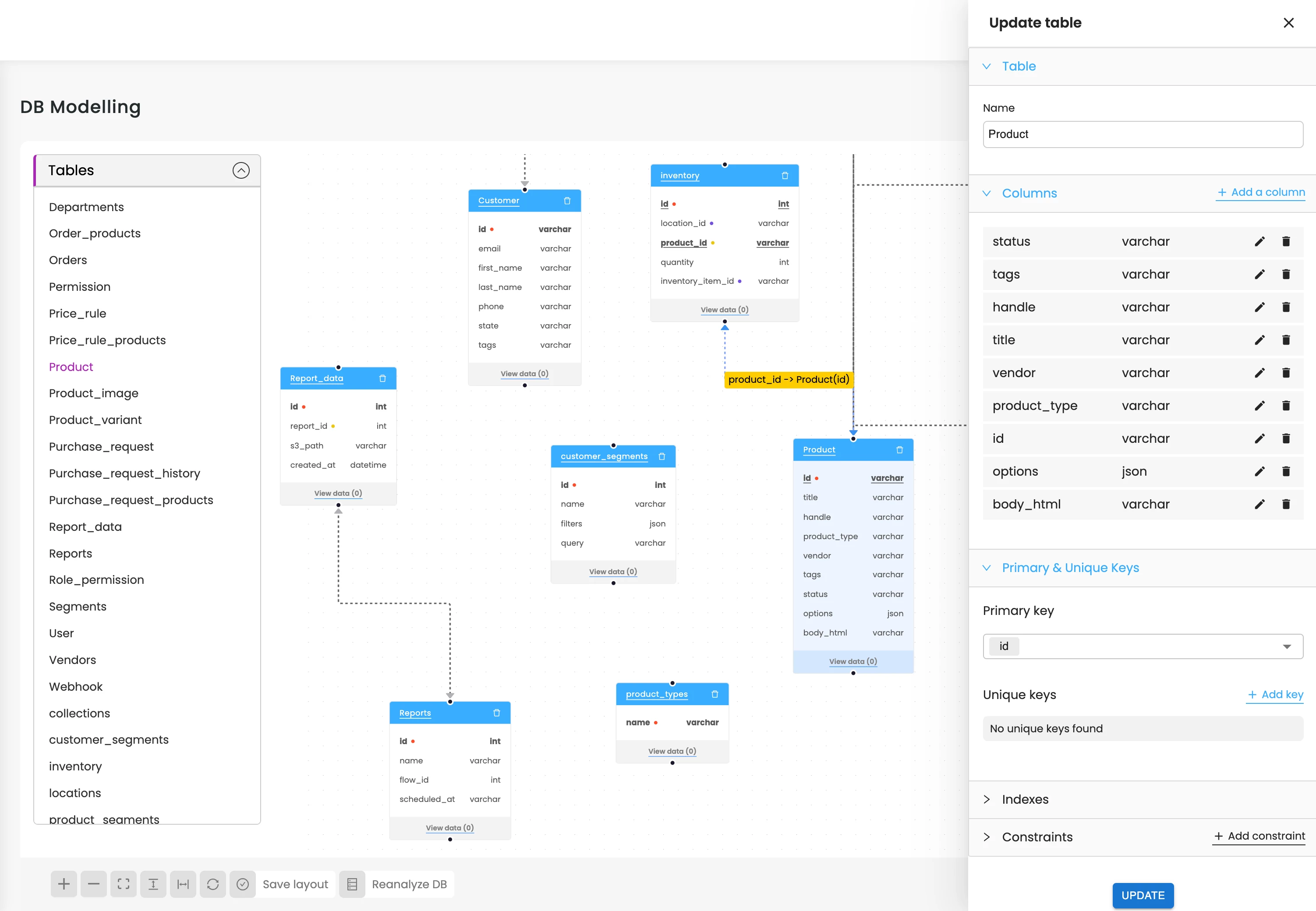

Expand
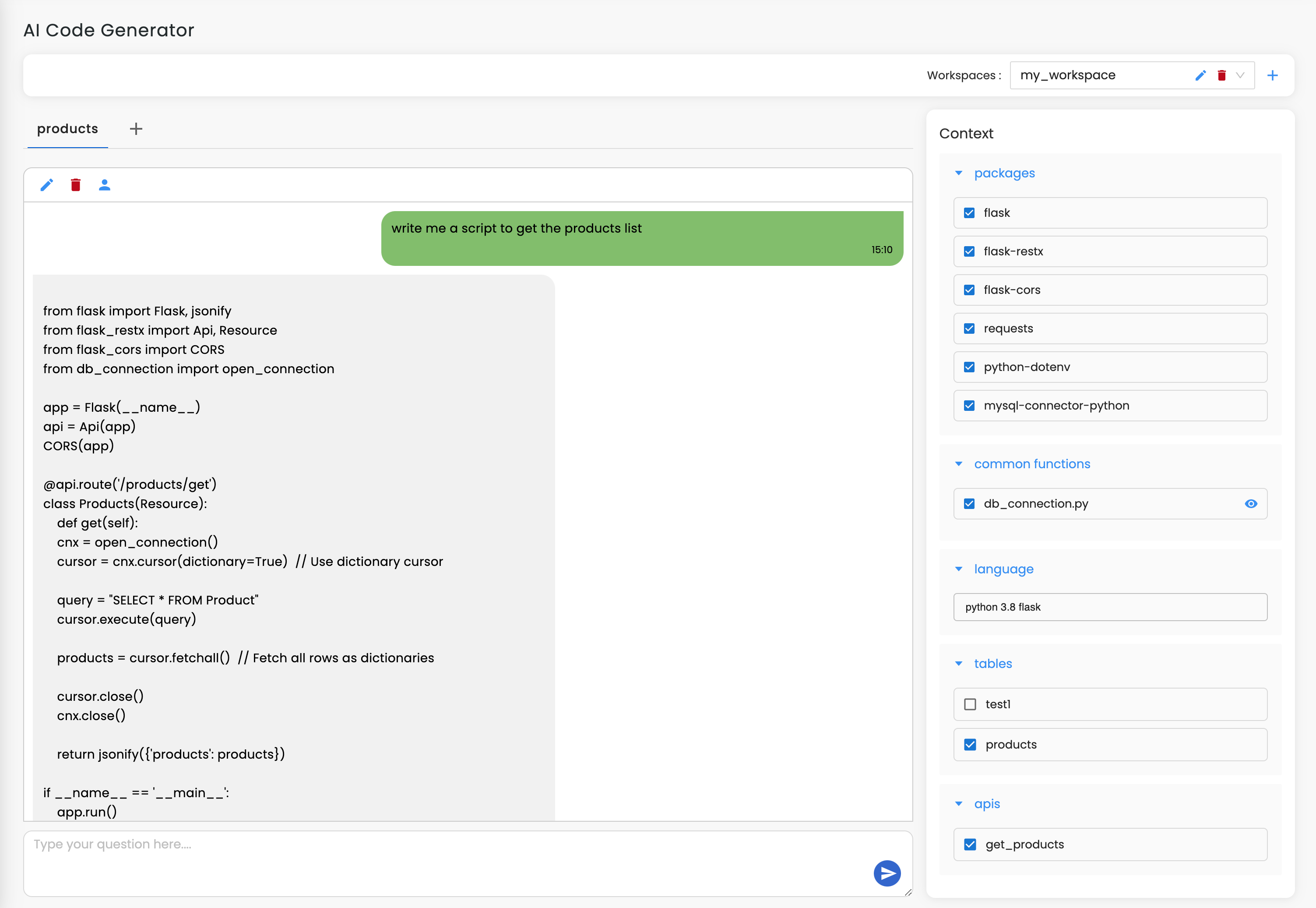

Expand


Expand


Expand


TESTIMONIALS
Real Stories, Real Results with Workik
"I refactored our entire MySQL schema using Workik’s AI—clean, fast, and no guesswork."

Freya Janssen
Senior Backend Engineer
"We now use Workik to auto-document our schemas — everyone on the team stays aligned."

Zephyr Valencia
Technical Writer
"Workik helped me finally understand how joins and relationships actually work in real DBs."

Josh Gallagher
Junior Developer
What are some popular use cases for Workik AI's DB Schema Generator?


Popular use cases for Workik AI's DB Schema Generator include but are not limited to:
• Generate schemas for web apps like ecommerce, CRMs, or booking systems.
• Refactor legacy schemas with AI-suggested indexing and relationship improvements.
• Create NoSQL structures for apps like chat platforms or real-time dashboards.
• Auto-document large, complex databases for easier team onboarding.
• Generate mock data to test API endpoints without hitting production.
• Quickly prototype schemas for MVPs or feature-specific modules.
Do I need to set any context before using the DB schema generator?


No, adding context is optional — but it helps personalize and improve AI responses. You can include:
• Schema files (JSON/CSV) with tables and fields
• Database type like MySQL, PostgreSQL, MongoDB, etc.
• Entity structure such as relationships or key naming patterns
• Project-specific terms for domain-relevant suggestions
• Version control links from GitHub, GitLab, or Bitbucket
• Additional context types like code snippets, API blueprints, environment variables, and common functions
Can Workik AI generate both SQL and NoSQL database schemas?


Absolutely. Workik AI supports schema generation for SQL databases like MySQL, PostgreSQL, and Microsoft SQL Server, as well as NoSQL systems like MongoDB, Cassandra, and CouchDB. Just specify your target DB engine, and the AI will adapt the schema structure accordingly — whether that’s relational tables or document-based collections.
How do I use Workik AI to generate a schema from scratch?


You can start with a natural language prompt like “Create a database for an ecommerce platform with users, products, and orders”. Workik will instantly generate tables (or collections), relationships, and even constraints. For a more controlled setup, you can upload partial schemas in JSON or CSV and let the AI complete or optimize it.
Can Workik AI reverse engineer a schema from my existing database?


Yes. You can upload your current schema structure, and Workik will visualize it using an ER diagram and offer AI-driven suggestions for normalization, better indexing, or improved relationships. It’s especially useful for refactoring legacy databases or onboarding to modern DB standards.
How does mock data generation actually help in schema design?


Mock data helps you validate how your schema holds up under real usage. For example, if you're designing a table with constraints like unique emails or foreign key dependencies, Workik AI can auto-generate consistent test data to check for data integrity and structure reliability.
Can I collaborate with my team on schema development?


Yes. Workik allows you to invite your team to a shared workspace where everyone can co-edit, leave comments, and track changes to the schema.
Is Workik AI suitable for enterprise-grade database architecture?


Yes. Workik AI supports advanced features like composite primary keys, many-to-many relationships, indexing strategies, and schema export for enterprise stacks. Teams can also define access levels and integrate DB workflows into automation pipelines for production use.
Generate Code For Free

Database schema Question & Answer
A database schema is a blueprint or architecture of how data is organized in a database. It defines how the data is structured and the relationships between different parts of the data. A well-designed database schema is crucial for data integrity, performance, and scalability. Proper schema design, normalization, and optimization are fundamental to maintain a high-performance database.
Essential tools and frameworks for database management are:
1. Schema Design Tools:
MySQL Workbench, pgAdmin, DbSchema
2. ORM Frameworks:
Hibernate (Java), SQLAlchemy (Python), Sequelize (Node.js)
3. Database Migration Tools:
Flyway, Liquibase
4. Database Management Systems:
MySQL, PostgreSQL, SQLite, MongoDB
Popular use cases of database schema include:
1. Database Design:
Structuring data into tables, columns, and relationships.
2. Data Integrity:
Ensuring accuracy and consistency of data through constraints and validation rules.
3. Database Normalization:
Organizing data to reduce redundancy and improve data integrity.
4. Database Optimization:
Indexing and partitioning to enhance query performance.
5. Migration and Version Control:
Managing changes to the database schema over time.
Career opportunities and technical roles available for Database Schema experts include Database Administrator (DBA), Data Architect, Backend Developer, Data Engineer, Full-Stack Developer, and more.
Workik AI provides broad assistance for Database Schema related tasks, which includes
1. Schema Design:
Assists in designing database schemas with best practices and optimal structures.
2. Data Integrity:
Suggests constraints and validation rules to maintain data accuracy.
3. Normalization:
Provides recommendations for organizing data to minimize redundancy.
4. Optimization:
Analyzes and suggests indexing strategies for improved query performance.
5. Integration:
Ensures seamless integration with popular databases and ORMs.
4.75 out of 5, based on 1378 reviews
Explore more on Workik
Top Blogs on Workik
Get in touch
Don't miss any updates of our product.
© Workik Inc. 2025 All rights reserved.

